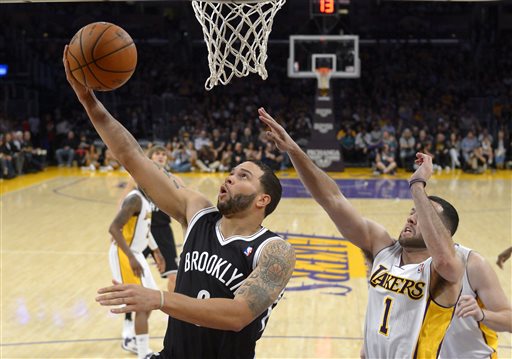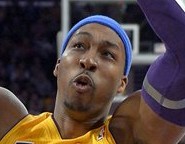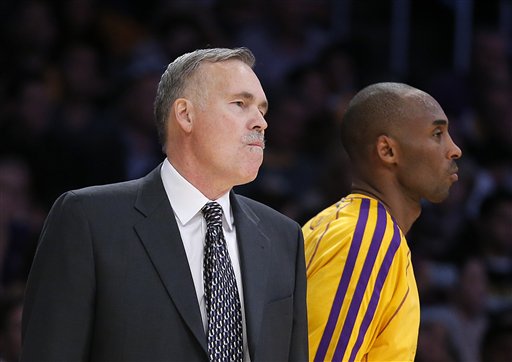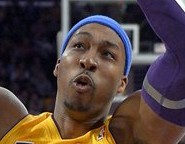Brook Lopez suffered a stress fracture to the fifth metatarsal of his right foot yesterday. Now, if you’re like me, the moment you heard that, all you saw was the words “fracture” and “foot,” filled in the rest as medical jargon, and began panicking. Well, after a bit of research, here’s what that jargon means, and why the panic is somewhat warranted — but not entirely.
What it is
Essentially, the metatarsal bones are the long bones in your foot. They connect to the tarsal bones (a cluster of bones in your feet) and the phalanges (which then connect to the toes).
Put your finger on top of your right pinky toe. Slide it down about an inch, then slide your finger back and forth against your foot. Feel those ridges? Those are your metatarsal bones. Lopez fractured his fifth metatarsal, which is the outermost of the metatarsus, or the one that leads out to your pinky toe.
How it happens
Brook suffered a stress fracture to the bone, which is exactly what it sounds like: a fracture brought upon by constant stress. Rather than an acute injury, which occurs when something directly strikes the bone, a stress fracture comes from gradual pressure over time. This pressure can take years to manifest as a fracture; it’s entirely possible that his quickness has been hindered for some time as a result. An additional way the fifth metatarsal can be weakened is by applying too much pressure to the anterior part of the foot. I can’t say for certain if that applies to Brook’s situation.
Treatment
I’ll leave this one to the expert:
For the chronic stress fracture operative treatment with a screw is ideal. It is not necessary to open the skin with a large incision to fix the fracture at all. We use a tiny puncture in the skin, and then insert a small pin into the Metatarsal guided with a live X-Ray machine called ‘fluoroscopy’. Once the pin has been inserted across the fracture into the canal of the metatarsal, it is then easy to insert a screw into the shaft of the metatarsal to facilitate healing. The size and type of the screw are very important. Athletes are allowed to bear weight on the foot immediately following surgery in a boot, but limit impact loading of the foot, particularly twisting activities.
Physiotherapy is an essential part of the recovery, maintaining flexibility of the foot, decreasing swelling, and stimulating tissue healing. We use an external bone stimulator in all athletes which is applied to the foot daily to speed up the healing process. Exercise can begin in a single plane (bike, elliptical trainer, swimming pool) by 4 weeks, but monitored according to swelling and discomfort. Running in a pool, with the help of a buoyancy belt, followed by running on a hard surface can begin once soreness is relieved, usually at 6-8 weeks, and then finally a return to full activities including twisting and pivoting by 8-10 weeks.
Dr. Mark S. Myerson, M.D. — Fifth Metatarsal Fractures and Surgery
Outlook
Brook isn’t the first NBA player to fracture his fifth metatarsal, and long-term results are mostly positive, though mixed:
- Brook’s twin brother, Robin Lopez, actually suffered the same injury in 2009.
- Then with the Kings, Mike Bibby fractured his fifth metatarsal in October of 2002, and returned to Sacramento’s lineup roughly eight weeks later. His right foot has had no injuries since, and Bibby put up career-best seasons in the years following the surgery.
- Wizards power forward Andray Blatche underwent surgery to repair a broken fifth metatarsal in June of 2010 and played in the team’s season opener four months later. That didn’t change the fact that he was Andray Blatche, though.
- As a freshman at Duke, Elton Brand shattered his left foot’s fifth metatarsal on December 27th. After two months of rehabilitation, he returned to the court on February 22nd. Brand retained his status as the #1 pick, and though his injury history is long and fruitful, he has not missed a game due to a left foot injury in the NBA.
- Another former #1 pick and general disappointment Kwame Brown suffered a fifth metatarsal fracture in August of 2004, missing about four months. He was largely the same player after the surgery as he was before.
- Lakers big man Pau Gasol suffered the same fracture in his left foot during the 2006 FIBA World Championships. Gasol underwent surgery on September 8th, 2006, and didn’t play until December 15th of that same year, missing 22 games. He has since made a full recovery.
- Nets small forward Damion James suffered the exact same injury last season, which caused him to miss roughly 10 weeks. It remains to be seen how he performs, though he’s looked active in preseason.
- Mike Miller suffered a chip fracture of the same bone in 2001, and only missed five games. It appears Lopez’s injury is more serious than Miller’s.
- Former Nets small forward Travis Outlaw suffered a stress fracture on the fifth metatarsal on his left foot in 2009. As you are well aware, he has yet to return to form.
- Both Bill Walton and Yao Ming suffered numerous foot injuries, a broken fifth metatarsal being one of them. Again, I would say that their situations are not analogous to Lopez’s.
Foot injuries are never “good” for big men, but it’s most encouraging that Gasol — a player similar to Lopez in play style — suffered no ill long-term effects from the surgery.
Lopez should make a full recovery with the right amount of rest and care. If the Nets rush him back, forcing him to apply pressure to the area before he’s ready, they risk seriously injuring him long-term. Yes, the Nets need him out there quickly to help the Nets and entice a potential Dwight Howard deal, but a rushed and doubly-injured foot kills both of those possibilities.
The long-term effects could prove beneficial, as the Nets training staff must take the time to understand why the stress fracture occurred and reassess their training regimen to strengthen that area of his foot. It may force Lopez to learn more about his body and make decisions accordingly as well.
Still, there’s no official timetable on how long the treatment takes. The Nets wish of 4-6 weeks seems wholly optimistic, as the soonest some players make it back trend closer to the 8-12 week range. It’s possible that with a shortened, compressed season, if he’s not healthy by the trade deadline of March 15th, they may decide to shut him down until 2012.
This information was gathered from various sources, and fact-checked by Dr. AllThatAmar, a licensed medical practician. His take: “I am confident that Brook can make it back and have a career where this chronic injury happens only once in his career.”


















